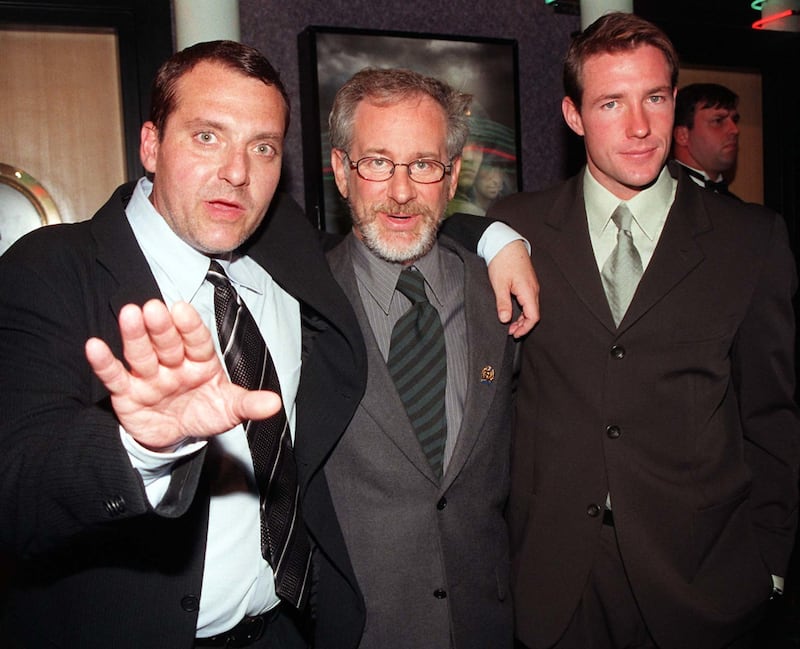Tom Sizemore, a tough-guy actor whose career, which included roles in Saving Private Ryan and Black Hawk Down, was overshadowed at times by his problems with substance abuse and the law, died on Friday in Burbank, California. He was 61.
The death was announced by his manager, Charles Lago. The cause was not immediately known, but Sizemore suffered a stroke on February 18th, which caused a brain aneurysm. He had been in a coma and on life support since then.
Sizemore could be intense, charismatic and manic in roles as soldiers, thugs, cops, killers and, in a television movie, baseball player Pete Rose. As Sgt Mike Horvath in Steven Spielberg’s Saving Private Ryan (1998), he was the devoted second in command to Captain Miller (played by Tom Hanks) in a small group of Army Rangers whose mission after the D-Day invasion was to locate a soldier whose three brothers had already died in battle.
Spielberg was not the only A-list director Sizemore worked with. In Oliver Stone’s Natural Born Killers (1994) he was an obsessed detective pursuing a young couple on a murder spree. In Michael Mann’s Heat (1995) he was a member of a crew of thieves led by Robert De Niro. And in Ridley Scott’s Black Hawk Down (2002), based on a botched US military raid in 1993 in Mogadishu, Somalia, to capture lieutenants of a brutal warlord, he was the commander of the 75th Ranger Regiment.
Friedrich Merz gets ready for Trump’s Oval Office endurance test
Determined not to let his murder silence him, friends of Dom Phillips finish his book on the Amazon
Elon Musk leaves Trump’s club, yet he was never quite part of it
Trump v Harvard: University faces existential battle against opponent that would have once been unimaginable
When Sizemore starred on the television series Robbery Homicide Division, a police procedural set in Los Angeles that aired in 2002-2003, Robert Philpot of the Fort Worth Star-Telegram said he was the main reason to watch.
“Using his oversized head, which hangs down slightly as if it were too heavy for his body, and his expressive eyes,” Philpot wrote, “Sizemore projects complete authority, keeping underlings as well as suspects in line.”
Sizemore at the time was dealing with serious drug problems, which dated to the 1990s. Over the years he used heroin, crystal methamphetamine and cocaine, and he was in and out of rehab.
“How long sober now?” Larry King asked him on his CNN show in 2010.
“Three hundred twenty-six days,” Sizemore said.
“What was the longest you were ever sober before that?” King asked.
“A couple minutes,” Sizemore said. “No, that’s not true. I got sober in ’97 and was sober through 2002.”
In 2003 he was convicted of physically abusing his former girlfriend, Heidi Fleiss, who in the 1990s ran an upscale prostitution ring and was referred to in the news media as the Hollywood Madam.
In a letter to the judge who sentenced him, Sizemore wrote, “I am convinced that if I had not been under the influence of drugs, I would have controlled my behaviour.”
He served eight months in prison.
In October 2004 he pleaded guilty to a felony count of possessing methamphetamine and was placed on probation. The probation was revoked in 2005 when he was caught using a prosthetic device to fake a drug test. His probation was later reinstated.
And in 2007 he served several months in jail for violating his probation after being arrested in a hotel in Bakersfield, California, for possessing methamphetamine.
“God’s trying to tell me he doesn’t want me using drugs because every time I use them I get caught,” Sizemore said in a jailhouse interview with the Associated Press.
He participated in 10 episodes of the reality series Celebrity Rehab With Dr Drew in 2010-2011, along with Fleiss, former basketball player Dennis Rodman, actor Mackenzie Phillips and others.

In an article in The New York Times Magazine in 2009 about the series, Chris Norris wrote that Sizemore had fallen “from an Olympus populated by Pacino, De Niro, Spielberg and Scorsese to this beige-carpeted, cable-only Hades.”
Thomas Edward Sizemore Jr was born on November 29th, 1961, in Detroit. His father was a lawyer. His mother, Judith (Schannault) Sizemore, worked for the city of Detroit’s ombudsman.
After graduating from Wayne State University in Detroit with a bachelor’s degree in theatre in 1983, he earned a master’s in the same subject from Temple University in 1986. Three years later, he made his debut on television, in the series Gideon Oliver, and on film, in Lock Up, starring Sylvester Stallone.
Lock Up was a flop but United Press International wrote that Sizemore, as a “whacked-out scheming loser of an inmate”, had emerged “with semi-star potential.”
His role as a mobster in Witness Protection (1999) earned him a Golden Globe nomination for best performance by an actor in a made-for-TV movie or miniseries. That year he and eight other actors from Saving Private Ryan were nominated for a Screen Actors Guild Award for outstanding cast.
Sizemore continued to play characters on either side of the law, and despite his substance abuse problems, he remained busy for the rest of his career. He portrayed an internal affairs investigator on five episodes of Hawaii Five-O in 2011 and 2012; a CIA agent assigned to rescue three American journalists taken hostage in Radical (2017); and a commander in the science-fiction film Battle for Pandora (2022).
And in a preternaturally chilling role he played a depraved building manager who is tried for kidnapping and killing a little boy in a 2015 episode of Law & Order: Special Victims Unit.
Sizemore is survived by his mother; his twin sons, Jagger and Jayden; his brother, Paul; his half sister, Katherine Sizemore; and his half brother, Charles Sizemore. His brother Aaron died last year. His marriage to Maeve Quinlan ended in divorce.
– This article originally appeared in The New York Times













